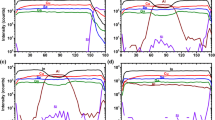Abstract
A series of Cu-rich CuInSe2 epitaxial thin films were grown by molecular beam epitaxy on GaAs(00l) substrates from elemental sources at a growth temperature of 450 °C. All samples were grown with an excess of Cu. Electron microprobe analysis (EPMA) indicated a Cu/In ratio of about 2.1–2.6 in the as-grown films. Additionally, the Se / (In+Cu) ratio was observed to be ~0.95 indicating that the films were slightly Se poor. These Cu-rich samples were etched in a KCN solution for periods ranging from 30 seconds to 3 minutes. EPMA measurements indicated that the bulk Cu/In ratio was reduced to ~0.92 in all films regardless of etching time. Atomic force microscopy (AFM) was used to characterize the topology of each sample before and after etching. These measurements indicated that the precipitates present on the as-grown films were removed and large nearly isotropic holes were etched into the sample to a depth of over 1000 Å even for etching times as short as 30 seconds. The samples were also evaluated both before and after etching using a Phillips MRD diffractometer with parallel beam optics and a 18,000 watt Cu rotating anode X-ray source in the chalcopyrite [001], [101], and [112] directions. A peak was observed at ~15 degrees in the [001] scan after etching consistant with the presence of the ordered vacancy compound, CuIn3Se5. Additionally the integrated intensity ratios of the chalcopyrite (202) reflection to the chalcopyrite (101) reflection ∞(fCu-fIn)2 along the [101] direction indicated the presence of a near-surface region containing cation sublattice disorder that was subsequently removed by the etching process.
Similar content being viewed by others
References
S. Chichibu, Y. Harada, M. Uchida, T. Wakiyama, S. Matsumoto, S. Shirakata,S. Isomura, and H. Higuchi, J. Appl. Phys. 76, 3009 (1994).
Contreras, M.A, Tuttle, J., Gabor, A., Tennant, A. Ramanathan, K., Asher, S. Franz, A. Keane, J., Want, L., Scofield, J., and Noufi, R, Proc 1st World Conf. PhotovoltaicEnergy Conversion, (Hawaii, USA Dec. 5–9, 1994).
Niki, S., Shibata, H., Fons, P. J., Yamada, A., Obara, A., Makita, Y., Kurafuji, T., Chichibu, S., Nakanishi, H, Appl. Phys. Lett 67, 1289 (1995).
J.R. Tuttle, D. Albin, R.J. Matson, and R. Noufi, J. Appl. Phys. 66, 4408 (1989).
O. Hellman, S. Tanaka, S. Niki, and P. Fons, J. Mat. Sci. Res. (in press).
D. Cahen et al., Solar Cells 16 529 (1986).
R. Klenk, R. Menner, D. Schmid, D. Cahen, and H.W. Schock, Proc. 9th Photov. Sol. En. Conf., Freiburg 469 (1989).
S. Niki, Y. Makita, A. Yamada, O. Hellman, PJ. Fons, A. Obara, Y. Okada, R. Shioda, H. Oyanagi, T. Kurafuji, S. Chichibu, H. Nakanishi, J. Cryst. Growth 150, 1201 (1995).
H. Ran and A. Rabenau, J. Solid State Chem. 1, 515 (1970).
Author information
Authors and Affiliations
Corresponding author
Rights and permissions
About this article
Cite this article
Fons, P., Niki, S., Yamada, A. et al. The Effects of KCN Etching on Cu-Rich Epitaxial CuInSe2 Thin Films. MRS Online Proceedings Library 426, 213–218 (1996). https://doi.org/10.1557/PROC-426-213
Published:
Issue Date:
DOI: https://doi.org/10.1557/PROC-426-213




